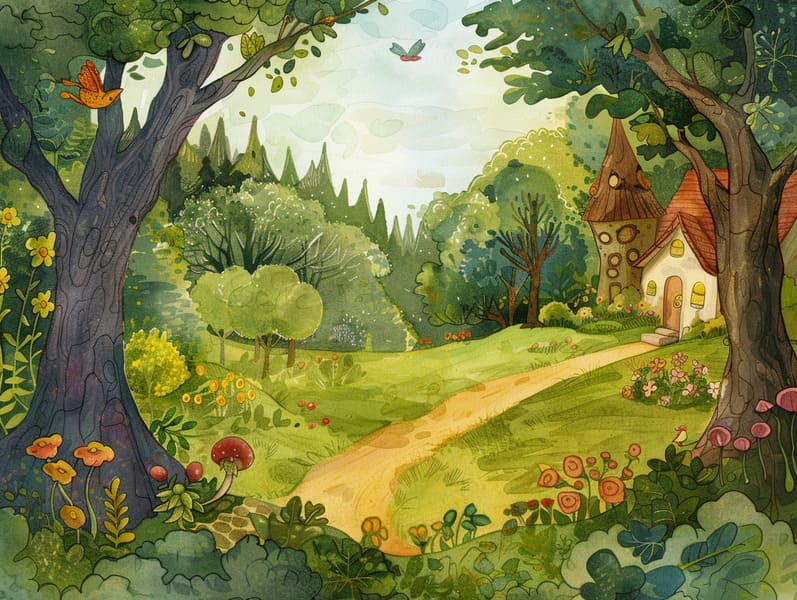
Historical fairy tales have historical significance. These tales have been recounted from one generation to the next ages before they were ever published. They sprang from a variety of societies, including European traditions. They were initially disseminated among older generations, often carrying themes and messages reflective of the societal norms and beliefs of the time.
The Brothers Grimm, the two Grimm brothers, were among the first to gather many of these beloved tales. Their compilation, "Grimm's Story Collection," included classics like "The Story of Cinderella," "The Bread Crumb Trail," and "Little Snow White," which have since become classics in the world of classic fairy tales. Similarly, Hans Andersen's magical narratives, such as "The Mermaid," and "The Duckling that Could," have captured hearts worldwide, ensuring their place in the pantheon of iconic fairy tales.
Despite their age, traditional fairy tales remain as important as ever, especially as bedtime stories for kids. These charming stories are now available in various formats, including vibrantly illustrated books, whimsical animations, and free fairy tales online.
Their lasting presence can be linked to several captivating elements:
Vital Lessons: Traditional fairy tales often teach important moral lessons. Fairy tales like "The Wolf and the Liar" teach the virtue of honesty, while "The Hare and the Tortoise" show the values of perseverance and humbleness. These stories offer young readers clear distinctions between correct and incorrect, guiding their moral compass in a kind yet deep way.
Empathy and Awareness: Old fairy tales frequently depict beings facing difficulties and adversities, urging listeners to resonate with their struggles and applaud their triumphs. For instance, "The Story of Beauty and the Beast" highlights the value of looking beyond appearances to recognize the true nature of a individual, nurturing awareness and understanding.
Cultural Understanding: Many ancient fairy tales are rooted in the cultural contexts from which they came. Reading these tales can provide illuminating insights into different beliefs, developing a sense of cultural understanding and appreciation.
Fantasy and Imagination: The fanciful elements in fairy tales—magical kingdoms—ignite children’s visions and dreams. These narratives guide readers to imaginary realms, unleashing inventive thinking and a sense of curiosity that lasts a lifetime.
Ancient fairy tales are not only charming but also teaching. They work as magical tools in strengthening various mind and heart abilities in kids. When traditional fairy tales are voiced, they boost linguistic abilities by teaching new linguistic elements and sophisticated sentence structures. This practice also cultivates hearing abilities and mindfulness, as young readers hang on every word, excited to see what happens next.
Furthermore, talking about the themes and characters of traditional fairy tales can sharpen intellectual skills and critical thinking. Children are educated to recognize patterns, predict happenings, and get cause and effect. these guys These reflections also assist the young reveal their thoughts and feelings, boosting their emotional intelligence.
In today’s online age, the abundance of digital fairy tales has made these stories more obtainable than ever. Digital sites and software share wide arrays of bedtime fairy tales that can be enjoyed or listened via anytime, anywhere. Fairy tales spoken are particularly in demand, supplying an delightful method for the young to savor these whimsical stories. Narrated books and read-to-me stories guide characters and settings to life, often paired with entrancing background sounds and musical scores that elevate the storytelling experience.
The lasting appeal of old fairy tales lies in their ability to evolve to modern days while staying true to their core messages. Contemporary takes of these narratives often present more different characters and modern settings, making them accessible to today’s audience. However, the key lessons of boldness, empathy, and integrity remain unchanged, continuing to impact children of all ages.
Classic fairy tales also offer a sense of reassurance and familiarity. They impart upon a well-arranged narrative with a unmistakable beginning, middle, and end, often drawing to a close with the solving of conflicts and the triumph of rightness over wrongness. This regularity can be heartening for the young, extending a sense of unwaveringness in an dynamic world.
Traditional fairy tales continue to fascinate and instruct new generations, maintaining their attraction and relevance in modern society. As children's night stories, they supply a perfect blend of allure and teaching, encouraging moral values, empathy, and creativity. The abundance of online storybooks and the well-liked nature of fairy tales recited validate that these timeless fairy tales remain reachable to new generations.
By maintaining and conveying these narratives, we continue to celebrate the rich tapestry of myths and cultural heritage. Whether you are viewing a artistically illustrated book, accessing a digital library, or listening via an read-aloud book, the loveliness of traditional fairy tales is always within reach. These tales show us of the unfading impact of storytelling and its ability to hold us together across time and space.
No matter if you are exploring a beautifully illustrated book, exploring a internet library, or listening via an narrated book, the radiance of bedtime fairy tales is always within reach.
These narratives teach us of the endless power of narratives and its ability to draw us together across eras and regions, casting a charm that delights and instructs alike.